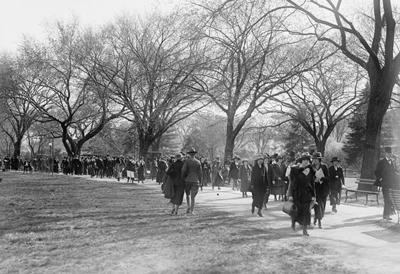Cherry Blossoms at the Nation’s Capital
 Above: Cherry blossoms and the Jefferson Memorial, photo by Michael Foley (Flickr).
Above: Cherry blossoms and the Jefferson Memorial, photo by Michael Foley (Flickr).
Spring in D.C. is traditionally marked by the blooming of the cherry trees that line the Tidal Basin and the Cherry Blossom Festival that marks the occasion. Beyond their aesthetic appeal, the cherry trees represent a long relationship with the government of Japan dating back to the original gift of 2000 trees from the City of Tokyo in 1910. Unfortunately those 2,000 trees arrived diseased and had to be burned to prevent the spread of the insects. However, private donors and the First Lady Helen Taft continued to support the planting of cherry trees in DC. Dr Jukichi Takamine, who had funded the original gift, again put up money for the purchase of the trees (the company he founded, Daiichi Sankyo is still a sponsor today). Taken from a variety of cherry trees lining the Arakawa River in Tokyo, 3,020 cuttings (or “scions”) arrived for planting in 1912.
Although the planting was marked with a ceremony involving First Lady Helen Taft and Viscountess Chinda (wife of the Japanese Ambassador), the first true Cherry Blossom Festival did not occur until 1935. Since that time, the gift has been reciprocated several times, as clippings from the DC cherry trees have been sent back to Japan to repair damage (from World War II and other incidents of flooding) to trees that line the Arakawa River. Starting in 1997, the United States National Arboretum has helped to take clippings from the original 1912 cherry trees in order to preserve their genetic heritage. From 2002-2006, 400 trees bred from those clipping were planted to preserve the integrity of the grove.
The cherry trees have also been a site of protest over the years. In 1938, women chained themselves to the trees to protest the building of the Thomas Jefferson Memorial (which necessitated the cutting of some of the trees). The issue was resolved when the government promised to re-plant new trees. During World War II, four cherry trees were cut down on December 11th, in what was suspected to be a retaliatory protest against the Japanese following Pearl Harbor. The trees were renamed “Oriental” instead of “Japanese” for the duration of WWII in order to prevent further attacks.
The trees have become a central symbol of Washington DC and draw over a million tourists each year. There are dozens of events throughout the Festival that incorporate many local communities and groups. This year’s festival marks the 99th anniversary of the original planting and plans are already being developed for a centennial celebration next year.
Sources:
- National Park Service “History of the Cherry Trees”, http://nps.gov/cherry/cherry-blossom-history.htm
- http://www.nationalcherryblossomfestival.org/about/history/

Visitors take a stroll through Potomac Park to admire the cherry blossoms in 1919. Photo courtesy of the Library of Congress, LC-DIG-hec-12001
Click here to read more about the history of the cherry blossoms on the National Museum of American History Blog, O Say Can You See?



The viewing of cherry blossoms in Japan is more than just an appreciation of the beauty, as many enjoy the camaraderie of family and friends. Festivals can be found throughout Japan no doubt due to the “sakuras” stature as the national flower. It is a time to enjoy good sake, good food, family and the beauty of spring. On your next visit to Japan, you too will be in awe of the Cherry Blossom.
I have always been fascinated by the beauty of the cherry blossoms in Japan. Never been in the city to personally see its grandeur but have imagined what it would be like to have seen it in person.
[…] apanews.si.edu/2011/04/12/cherry-blossoms/ […]